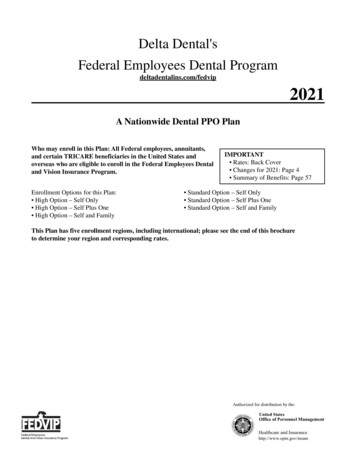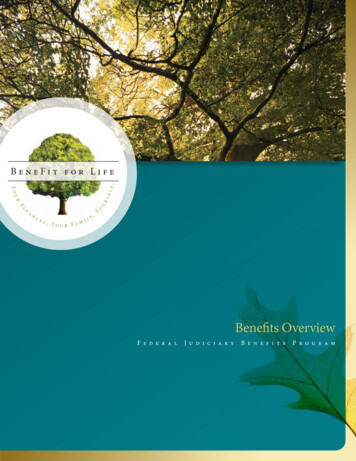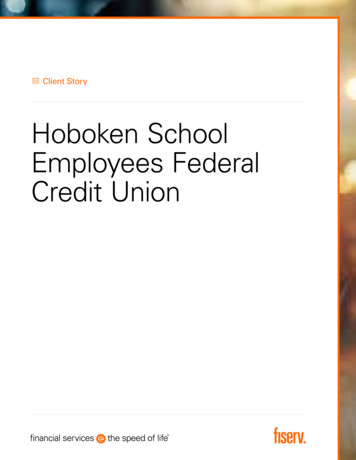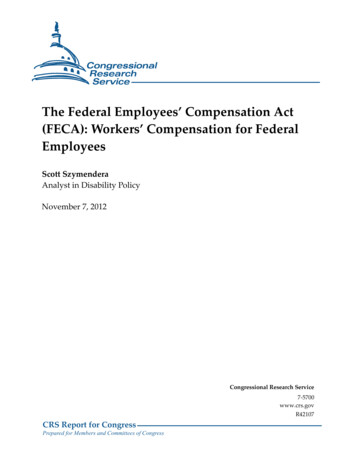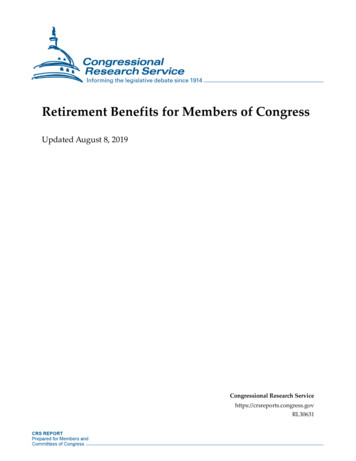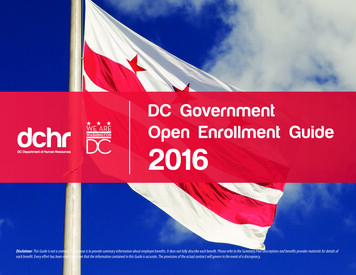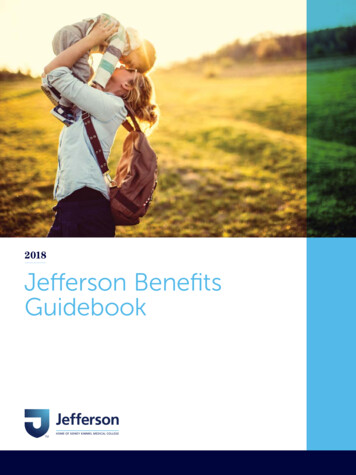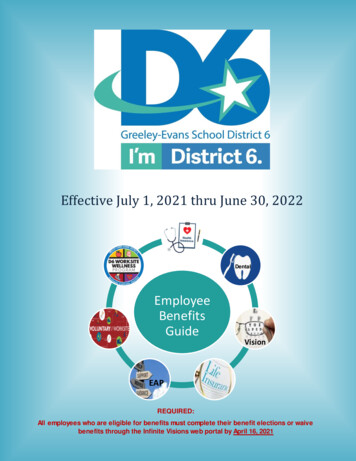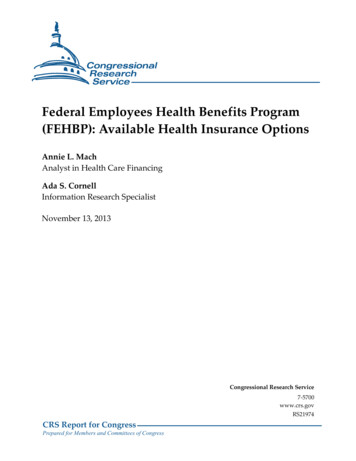
Transcription
Federal Employees Health Benefits Program(FEHBP): Available Health Insurance OptionsAnnie L. MachAnalyst in Health Care FinancingAda S. CornellInformation Research SpecialistNovember 13, 2013Congressional Research Service7-5700www.crs.govRS21974CRS Report for CongressPrepared for Members and Committees of Congress
FEHBP: Available Health Insurance OptionsSummaryFEHBP is generally available to federal employees, annuitants, and their dependents. Eligibleindividuals may elect coverage in an approved health benefits plan for either individual or familycoverage. For the 2014 plan year, there are about 256 different plan choices, including allregionally available options. As a practical matter, an individual’s choice of plans is often limitedto 10 to 15 different plans, depending on where the individual resides. While enrollees have arange of choices, they typically decide which options best match their needs, the amount of theirwages they will contribute to health insurance, and how risk-averse they are to potential out-ofpocket costs.While most federal employees or annuitants reaching age 65 are automatically entitled toMedicare Part A, Medicare-eligible employees may also voluntarily choose to enroll in MedicarePart B and Part D. For individuals covered under a FEHBP plan as an annuitant, Medicare is theprimary payer and FEHBP is the secondary payer. As a secondary payer, FEHBP could cover ashare of Medicare deductibles and coinsurance for any services that are covered by both plans,and FEHBP would continue to reimburse for its covered services that are not covered byMedicare.FEHBP is administered by the Office of Personnel Management (OPM), which is statutorilygiven the authority to contract with qualified carriers offering plans and to prescribe regulationsnecessary to carry out the statute, among other duties. Some of OPM’s additional duties includecoordinating the administration of FEHBP with employing offices, managing contingency reservefunds for the plans, and applying sanctions to health care providers according to the prescribedregulations.Beginning in 2014, Members of Congress and certain congressional staff will no longer beeligible to enroll in a plan offered under FEHBP as an active employee; however, if they enroll ina health plan offered through a small business health option program (SHOP) exchange, they willremain eligible for an employer contribution toward coverage. For information about healthbenefits for Members and designated staff, please see CRS Report R43194, Health Benefits forMembers of Congress and Certain Congressional Staff, by Annie L. Mach and Ada S. Cornell.Congressional Research Service
FEHBP: Available Health Insurance OptionsContentsFEHBP Basics. 1Eligibility . 1Election of Coverage and Plan Choices . 3Plan Facts. 3Premiums. 4Benefits . 5FEHBP Carriers . 6FEHBP Plans . 7High-Deductible Plans Combined with Tax-Advantaged Accounts. 9Consumer-Driven Health Plans . 9High-Deductible Plans with an HSA or HRA . 10Flexible Spending Accounts and Their Role in FEHBP . 11Medicare and FEHBP . 12Affordable Care Act and FEHBP . 13Conclusion . 13FiguresFigure 1. Top 10 Parent Organizations, by Covered Policy Holders, 2013 . 7TablesTable 1. Standard and Basic BCBS Plans, 2014 . 8AppendixesAppendix A. OPM’s Role in FEHBP. 14Appendix B. The United States Postal Service and FEHBP . 21ContactsAuthor Contact Information. 22Congressional Research Service
FEHBP: Available Health Insurance OptionsFEHBP BasicsThe statute governing the Federal Employees Health Benefits Program (FEHBP) is found in Title5 of the U.S. Code, Chapter 89. The program is administered by the Office of PersonnelManagement (OPM), which is statutorily given the authority to contract with qualified carriersoffering plans and to prescribe regulations necessary to carry out the statute, among other duties.(See Appendix A for a description of OPM’s role in FEHBP.)The federal government is the largest employer in the United States, and FEHBP is the largestemployer-sponsored health insurance program. FEHBP covers about 8.2 million individuals,providing an estimated 47 billion annually in health care benefits. The participation rate amongeligible enrollees is about 90% (85% of eligible individuals enroll in FEHBP as the primarypolicy holder, and another 5% are covered as a family member).1EligibilityEligible enrollees include current federal employees, the President, annuitants, and eligible familymembers.2 Active Members of Congress and certain congressional staff do not receive healthbenefits through FEHBP as a benefit of their employment, but may be eligible to enroll in FEHBPin retirement.3 Newly hired employees have 60 days from their entry on duty date to sign up foran FEHBP plan.4 Part-time workers are also eligible for coverage, but generally they are requiredto pay a larger share of premiums than full-time employees.5In order to be eligible for FEHBP in retirement, an individual (1) must be entitled to retire on animmediate annuity under a retirement system for civilian employees (including FERS MRA 10retirements)6 and (2) must have been continuously enrolled (or covered as a family member)1OPM, “Fact Sheet: 2013 Federal Benefits Open Season for Health Benefits, Dental and Vision Insurance and FlexibleSpending Accounts,” available from OPM.2Section 8901 of the FEHBP statute lists all of the eligibility groups, including for example, certain employees firstemployed by the government of the District of Columbia before October 1, 1987, among others. Additionally,eligibility information is provided in the FEHB Program Handbook, under “Eligibility for Health lity-for-health-benefits/.3Section 1312(d)(3)(D) of the Patient Protection and Affordable Care Act (ACA, P.L. 111-148, as amended) requiresthat the only plans the federal government will be able to make available to Members of Congress and certaincongressional staff will be those that are created under ACA or offered through an exchange. OPM issued a final rulethat amends FEHBP eligibility to comply with Section 1312(d)(3)(D) of ACA on October 2, 2013 (“Federal EmployeesHealth Benefits Program: Members of Congress and Congressional Staff,” 78 Federal Register df/2013-23565.pdf). For more information about health benefitsavailable to Members of Congress and certain congressional staff under ACA and the OPM final rule, see CRS ReportR43194, Health Benefits for Members of Congress and Certain Congressional Staff, by Annie L. Mach and Ada S.Cornell.4For newly hired employees, FEHBP coverage begins on the first day of the first pay period that begins after theemployee’s agency receives the employee’s enrollment request.5Certain temporary federal employees may also be eligible for FEHBP. For example, temporary employees who havecompleted one year of continuous service are eligible, and such employees pay the total premium amount.Additionally, in July 2012 OPM extended FEHBP eligibility to temporary federal firefighters (77 Federal Register42417, July 19, 2012). For more information about coverage for temporary federal firefighters, ndex.asp.6A separating Federal Employees Retirement System (FERS) employee who is eligible for an immediate annuity underthe minimum retirement age and 10 years of service (MRA 10) provision may receive the benefits immediately or(continued.)Congressional Research Service1
FEHBP: Available Health Insurance Optionsunder FEHBP for the five years of service immediately before the date the annuity starts, or forthe full period(s) of service since their first opportunity to enroll (if less than five years). The fiveyear requirement period can also include coverage under the Uniformed Services Health BenefitsProgram (also known as TRICARE) as long as the individual was covered under FEHBP at thetime of retirement.7Eligible family members include a spouse (or a valid common law marriage partner),8 childrenunder age 26, and continued coverage for qualified disabled children aged 26 years or older whoare incapable of self-support because of a mental or physical disability that existed before age26.9 Under the Civil Service Retirement Spouse Equity Act of 1984, certain former spouses (offederal employees, former employees, and annuitants) may qualify to enroll in a health benefitsplan under FEHBP.10TRICARE and Civilian Health and Medical Program of the Department of Veterans Affairs(CHAMPVA) eligible FEHBP annuitants, survivors, and former spouses may suspend theirFEHBP enrollment and then return to FEHBP during the open season, or return to FEHBPcoverage immediately if they involuntarily lose this non-FEHBP coverage. Annuitants or formerspouses who are enrolled in Medicare Parts A and B may suspend FEHBP enrollment to enroll ina Medicare Advantage plan (basically, a Medicare HMO or regional preferred providerorganization [PPO]), with the option to re-enroll in FEHBP during open season, or sooner, if theyinvoluntarily lose coverage or move out of the Medicare Advantage plan’s service area.Federal employee reservists who are placed in a leave without pay status when called to activeduty for more than 30 days can keep their FEHBP coverage for up to 18 months. The reservist isresponsible for paying the enrollee share of the premium during the first 12 months, and theagency pays the agency’s share.Since May 1, 2012, eligible Indian tribes, tribal organizations, and urban Indian organizationshave been allowed to purchase FEHBP for their tribal employees.11 The tribe or tribal(.continued)may postpone receiving an annuity to lessen the age reduction applicable to persons under age 62. If the individual iseligible for an MRA 10 annuity and is not applying for the annuity at the time of separation, he or she may reenroll inFEHBP when the annuity begins. However, if the individual applies for an immediate annuity under the MRA 10provisions and later decides to postpone the annuity starting date he or she would not be able to enroll in FEHBP.Individuals retiring under the Civil Service Retirement System, who qualify for an immediate annuity, must retire on animmediate annuity and cannot postpone receiving the annuity (and therefore cannot postpone receiving FEHBP).7OPM has the authority to waive the five-year requirement when it determines that it would be against equity and goodconscience to not allow an annuitant to be enrolled in FEHBP (P.L. 99-251). For more information, see the FEHBProgram Handbook, under “Annuitants and Compensationers,” ensationers/.8On June 26, 2013, the U.S. Supreme Court ruled that Section 3 of the Defense of Marriage Act (DOMA) isunconstitutional. As a result of the decision, OPM has stated that all legally married same-sex spouses are consideredeligible family members under FEHBP. Additionally, the children (including step-children) of same-sex marriages aretreated the same way as children of opposite-sex marriages for eligibility purposes. For more information, are/carriers/2013/2013-20.pdf.9For more information on children’s eligibility up to age 26, see the Appendix of CRS Report R42741, Laws Affectingthe Federal Employees Health Benefits Program (FEHBP), by Annie L. Mach and Ada S. Cornell.10For more information about the history of FEHBP eligibility, see the “Eligibility” section in CRS Report R42741,Laws Affecting the Federal Employees Health Benefits Program (FEHBP), by Annie L. Mach and Ada S. Cornell.1125 U.S.C. §1647b.Congressional Research Service2
FEHBP: Available Health Insurance Optionsorganization is required to pay the government’s share of the premium, at a minimum, with theenrollee paying the remaining share. Tribes and tribal organizations are only allowed to purchasethis coverage for employees; coverage is not available to their annuitants.12 Approximately 53tribes with 10,000 tribal employees are currently enrolled.13Finally, certain individuals may be eligible to temporarily continue their FEHBP coverage aftertheir regular coverage ends, under Temporary Continuation Coverage (TCC). TCC is similar toCOBRA14 coverage offered to individuals in the private sector. Federal employees and familymembers who lose their FEHBP coverage because of a qualifying event, such as job loss (exceptfor gross misconduct), may be eligible for TCC. TCC enrollees may initially enroll in any FEHBPplan and may also change plans during open season, but they must pay the full premium for theplan they select (that is, both the employee and government shares of the premium) plus a 2%administrative charge. In general, TCC coverage is available to separating employees and theirfamilies for up to 18 months after the date of separation. Children aging out of their parent’s plan(at age 26) and former spouses can continue TCC for up to 36 months.Election of Coverage and Plan ChoicesFEHBP eligible persons may elect coverage in an approved health benefits plan through the“individual” or the “family” options. For the 2014 plan year, FEHBP offers enrollees a choice of15 plan choices that are available government-wide (although four are only open to certain typesof employees, e.g., State Department employees).15 In total, there are 256 different plan choices,including all regionally available options. In addition, many plans offer a choice of a standardoption, high option, and/or a high-deductible plan. As a practical matter, depending on where anenrollee resides, his or her choice of plans and options is limited to about 10 to 15 different plans.Plan details for all FEHBP plans are available on the website of the Office of PersonnelManagement (OPM)—http://www.opm.gov. Since 2007, those eligible for FEHBP (whether ornot they are actually enrolled) are also eligible to enroll in the Federal Employee Dental andVision Insurance Program (FEDVIP), which provides supplemental dental and vision insurance.Plan FactsParticipation in FEHBP is voluntary, and enrollees may change plans during designated annual“open season” periods. Individuals who are eligible for, but not enrolled in, FEHBP may alsoenroll in a plan during open season. The open season for the 2014 plan year is from November 11to December 9, 2013. Special enrollment periods are also allowed for those with a qualifyingspecial circumstance, such as marriage. Enrollees are not subject to pre-existing conditionexclusions.12§157 of the Indian Health Care Improvement Reauthorization and Extension Act of 2009 (S. 1790) as enacted by§10221(a) of P.L. 111-148.13OPM, “Fact Sheet: 2013 Federal Benefits Open Season for Health Benefits, Dental and Vision Insurance andFlexible Spending Accounts,” available from OPM.14For more information on COBRA, see CRS Report R40142, Health Insurance Continuation Coverage UnderCOBRA, by Janet Kinzer.15OPM. Full Sets of Rate Charts. /plan-information/premiums/.Congressional Research Service3
FEHBP: Available Health Insurance OptionsPremiumsThe government’s share of premiums is set at 72% of the weighted average premium of all plansin the program, not to exceed 75% of any given plan’s premium. The government’s contributionto a plan for a part-time worker is generally prorated.16 The maximum annual governmentcontribution for 2013 is 5,114 for self-only coverage and 11,378 for family coverage.17 Thepercentage of premiums paid by the government is calculated separately for individual and familycoverage, but each uses the same formula. Annuitants and active employees pay the samepremium amounts, although active employees have the option of paying premiums on a pre-taxbasis. The enrollee’s share of premiums will rise by an average of 4.4% in 2014, a larger increasethan the 3.7% increase in 2013.18 While some plans had no increases in premiums, others haddouble-digit premium increases. However, looking only at premium increases may not give acomplete picture of plan changes from one year to the next, as plans may also make changes inbenefits or cost-sharing.Setting PremiumsWith regard to setting premium rates, the statute governing FEHBP allows OPM to contract withcarriers on either an experience-rated basis or a community-rated basis. The premiums forexperience-rated FEHBP plans are based on the claims of the plan’s federal enrollees.Experience-rating in FEHBP is retrospective, with gains and losses carried forward in the nextyear’s premium.Community-rated plans are those whose payment is based on a per member per month capitationrate. Community-rating in FEHBP is prospective, and it has several different forms. Traditionalcommunity-rated (TCR) plans set the same rates for all groups in a community, regardless of thehealth risks and characteristics of any specific group. Alternatively, community-rating by classallows for rate adjustments among groups based on the age and sex distribution of each group.Adjusted community-rating allows for the use of experience of a particular group to influence thepremiums for that group.19 Community-rated plans in FEHBP do not vary rates for enrolleesbased on the enrollees’ characteristics; rather, community-rated plans use the various forms ofcommunity-rating to set a rate that considers some characteristics of its FEHBP enrollees butapplies the same rate to all FEHBP enrollees.All TCR community-rated plans in FEHBP use the similarly sized subscriber group (SSSG)method to set premiums. SSSGs are a carrier’s two employer groups that have a subscriber16Part-time workers (working 16 to 32 hours a week) hired on or after April 8, 1979, are entitled to a partialgovernment contribution in proportion to the number of hours they are scheduled to work in a pay period. Part-timeworkers hired before April 8, 1979 who have continued to serve on a part-time basis without a break in service areeligible for the full government contribution. Additionally, part-time employees who work less than 16 hours or morethan 32 hours per week are entitled to the full government contribution. The amount of the prorated governmentcontribution for a part-time employee is the ratio of scheduled part-time work hours to full-time hours (usually 80 hoursper biweekly pay period) multiplied by the government contribution for full-time employees enrolled in that plan. Thepart-time employee pays the difference between the total premium and the prorated government contribution.17This is the maximum government contribution for non-postal employees and annuitants. For information aboutpremiums for employees of the United States Postal Service, see Appendix B.18OPM, “Average FEHBP Premiums in 2014 for Annuitants & Non-Postal Employees,” available from OPM.19OPM, Carrier Handbook: Federal Employees Health Benefits Program, March 2003, http://www.opm.gov/carrier/handbook/carrier handbook.pdf.Congressional Research Service4
FEHBP: Available Health Insurance Optionsenrollment closest in size to the FEHBP subscriber enrollment (as of the date specified by OPMin rate instructions); use any rating method other than retrospective experience-rating; and meetthe criteria specified in the rate instructions by OPM. Using the SSSG method, the premiums ofFEHBP TCR community-rated plans are compared to the premiums of SSSGs to ensure thatFEHBP receives the lowest available premiums.Previously, non-TCR community-rated plans in FEHBP also used the SSSG method to setpremiums; however, beginning in plan year 2013, all non-TCR FEHBP community-rated plansmust meet a FEHBP-specific medical loss ratio (MLR).20 The 2014 FEHBP-specific MLR targetis 85%.An MLR is the ratio of plan incurred claims, including any expenditures that improve the qualityof health care, to a plan’s total premium revenue. The FEHBP-specific MLR is analogous to theMLR defined in the Patient Protection and Affordable Care Act (ACA, P.L. 111-148, asamended),21 which FEHBP plans are also subject to.22 However, the FEHBP MLR can bedifferent from the ACA MLR, and all non-TCR community-rated FEHBP plans will be subject toboth MLRs (all other FEHBP plans are only subject to the ACA MLR). FEHBP carriers willreport the same categories of information for the FEHBP MLR as they do for the ACA MLR, butthe FEHBP MLR calculation will only be based on the FEHBP population. Each year OPM willput forth the FEHBP MLR at least 12 months prior to the beginning of the plan year to which theMLR applies.If a plan falls below the FEHBP MLR threshold, the plan must pay a subsidization penalty into aSubsidization Penalty Account. All plans will pay into the account and the funds will be annuallydistributed on a pro-rata basis to the contingency reserves of all non-TCR community-rated plans.BenefitsAlthough there is no core or standard benefit package required for FEHBP, the statute requiresthat all plans cover basic hospital, surgical, physician, and emergency care. OPM may prescribereasonable minimum standards for health benefit plans. FEHBP follows the guidelines onpreventive care for children recommended by the American Academy of Pediatrics. FEHBPguidelines on preventive care for adults are based on accepted medical practice, and since 2011all FEHBP plans have covered ACA-required preventive care services without imposing costsharing requirements.23 OPM requires plans to cover certain special benefits includingprescription drugs (which may have separate deductibles and coinsurance); mental health care2077 Federal Register 19522, April 2, 2012. TCR plans set the same rates for all groups in a community, regardless ofthe health risks and characteristics of any specific group. In TCR, healthier groups subsidize less healthy groups bydesign, and the TCR plans cannot adjust premiums for any specific group. Because of this, OPM believes it isinappropriate to impose the new rate-setting methodology on TCR plans. Currently, the only plans that use TCR are instates that require TCR.21For more information about the ACA MLR, see CRS Report R42735, Medical Loss Ratio Requirements Under thePatient Protection and Affordable Care Act (ACA): Issues for Congress, by Suzanne M. Kirchhoff.22The ACA MLR provision requires that health insurance issuers, beginning in 2011, meet an MLR of 85% for largegroup plans. For more information, see CRS Report R42735, Medical Loss Ratio Requirements Under the PatientProtection and Affordable Care Act (ACA): Issues for Congress, by Suzanne M. Kirchhoff.23However, plans may choose to only waive cost-sharing when beneficiaries use in-network providers, so that ifbeneficiaries use out-of-network providers, they may still be responsible for cost-sharing under the terms andconditions of the plan.Congressional Research Service5
FEHBP: Available Health Insurance Optionswith parity of coverage for mental health and general medical care coverage; childimmunizations; and limits on an enrollee’s total out-of-pocket costs for a year, called thecatastrophic limit. Generally, once an enrollee’s covered out-of-pocket expenditures reach thecatastrophic limit, the plan pays 100% of covered medical expenses for the remainder of the year.Plans must also include certain cost-containment provisions, such as offering preferred providerorganization (PPO) networks in fee-for-service plans and hospital pre-admission certification.Additionally, since 2011, all plans offer tobacco cessation benefits in compliance with the U.S.Public Health Service’s 2008 clinical guidance on tobacco cessation. Enrollees do not pay copayments for the following benefits: (1) seven FDA-approved medications and (2) fourcounseling sessions per an attempt to quit smoking (with two covered attempts per year).Beginning in 2013, plans could choose (but were not required) to cover Applied BehaviorAnalysis (ABA) for children with autism.24FEHBP CarriersThe law defines a FEHBP “carrier” to be a voluntary association, corporation, partnership, orother nongovernmental organization engaged in providing, paying for, or reimbursing the cost ofhealth services, in consideration of premiums or other periodic charges payable to the carrier.25Each carrier contracts with OPM after a negotiation process that begins with OPM issuing itsannual “call letter” asking for benefit and rate proposals.26 Carrier contracts are at the legal entitylevel and not the parent organization. Therefore, a parent organization, such as KaiserPermanente, may have multiple carrier organizations within FEHBP.27 As illustrated in Figure 1,FEHBP enrollment is concentrated among a few parent organizations, with the vast majority ofenrollment concentrated in the Blue Cross Blue Shield Association (BCBSA) plans.28Approximately 94% of all policy holders in FEHBP are enrolled in the top 10 parentorganizations (by number of enrolled policy holders) shown in Figure 1.24Previously, ABA was considered an educational intervention rather than a medical therapy, and it could not becovered under FEHBP.255 USC §8901.26OPM, “Federal Employees Health Benefits Program Call Letter,” Letter No. 2013-04: March 21, hcare/carriers/2013/2013-04.pdf. See Appendix A for discussion ofcontract cycle and Annual Call Letters.27A “parent organization” is a company that owns all or enough of another firm to control its management. Thecontrolled firm is considered a subsidiary of the parent company. In some cases, the parent organization is the FEHBPcarrier (e.g., GEHA). In other cases, the parent organization may have multiple FEHBP carriers. For example, KaiserPermanente (KP) has the following subsidiary FEHBP carriers: KP of Georgia, KP of Colorado, KP of Hawaii, KPMid-Atlantic, KP of Northern California, KP Northwest, KP of Southern California, and KP of Ohio.28The Blue Cross Blue Shield Association (BCBSA) includes both the nonprofit national carriers operated by theBCBSA and the nonprofit local carriers typically organized at the state level. BCBSA does not include the for-profitWellPoint-Anthem carriers that use the Blue Cross Blue Shield marketing name. Approximately 96% of all individualsenrolled in the BCBSA plans are enrolled in plans offered by the nonprofit national carriers.Congressional Research Service6
FEHBP: Available Health Insurance OptionsFigure 1.Top 10 Parent Organizations, by Covered Policy Holders, 2013Blue Cross Blue Shield Association2,639,558GEHA304,319Kaiser239,561Mail Handlers148,223Aetna120,829National Association of Letter Carriers116,111American Postal Workers Union102,682United Health Group61,212EmblemHealth32,008Rural Carrier Benefit ,0003,000,000Number of Policy HoldersSource: CRS analysis of “FEHBP OPM Headcount Totals for 2013” data from OPM.Notes: The numbers in this figure represent enrollment of policy holders; the numbers do not includeenrollment of dependents.The Blue Cross Blue Shield Association (BCBSA) includes both the nonprofit national carriers operated by theBCBSA and the nonprofit local carriers typically organized at the state level. BCBSA does not include the forprofit WellPoint-Anthem carriers that use the Blue Cross Blue Shield marketing name. Approximately 96% of allindividuals enrolled in BCBSA plans are enrolled in the plans offered by the nonprofit national carriers.FEHBP PlansAn FEHBP health benefits plan is a group insurance policy or similar group arrangementprovided by a carrier to provide, pay for, or reimburse expenses for health services. The FEHBPstatute29 specifies three types of participating plans that are currently offered:30 The government-wide service benefit plan is the fee-for-service benefit planthat pays providers directly for services (this slot has always been filled by Blue295 USC §8903.The statute also specifies that OPM may contract with an indemnity benefit
Medicare Part A, Medicare-eligible employees may also voluntarily choose to enroll in Medicare . For individuals covered under a FEHBP plan as an annuitant, Medicare is the primary payer and FEHBP is the secondary payer. As a secondary payer, FEHBP could cover a . 1 OPM, "Fact Sheet: 2013 Federal Benefits Open Season for Health Benefits, .

